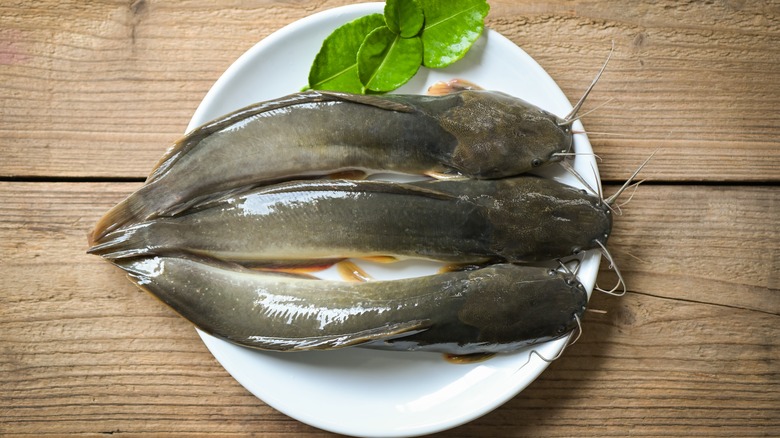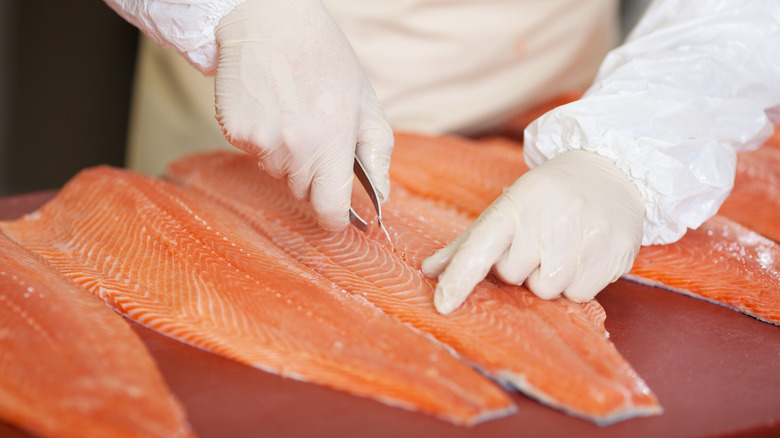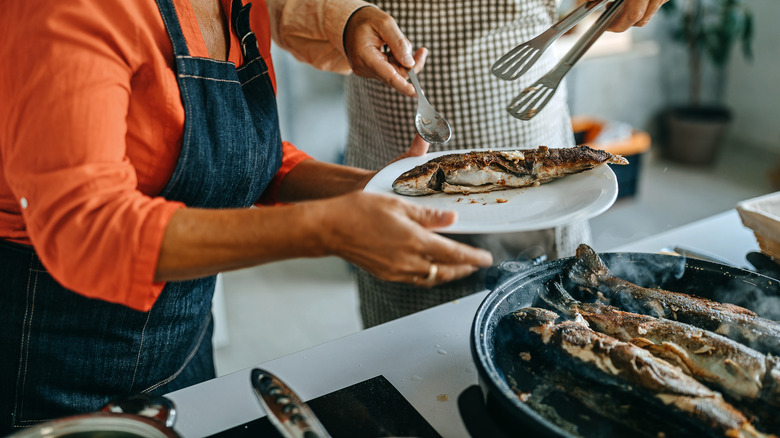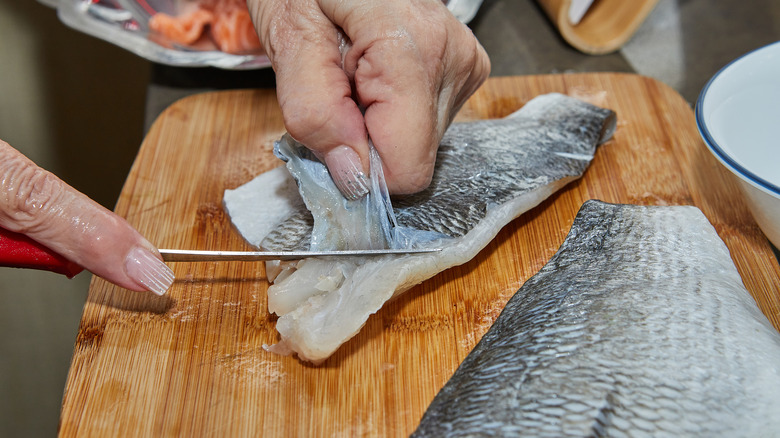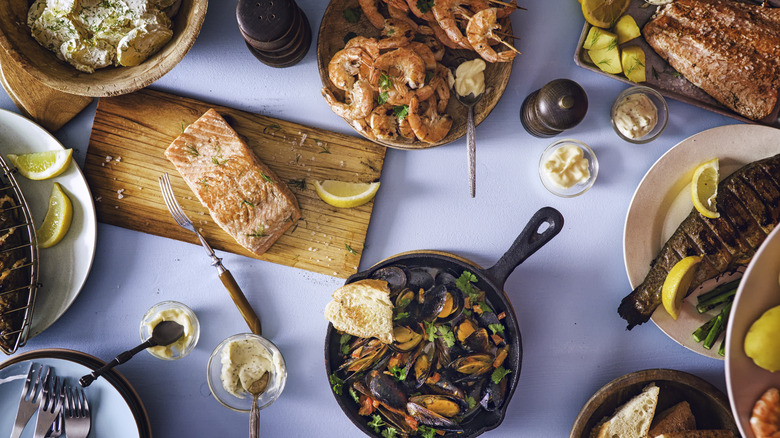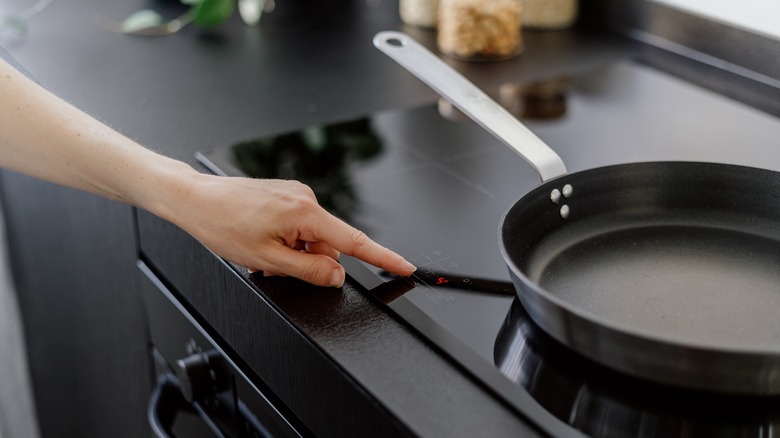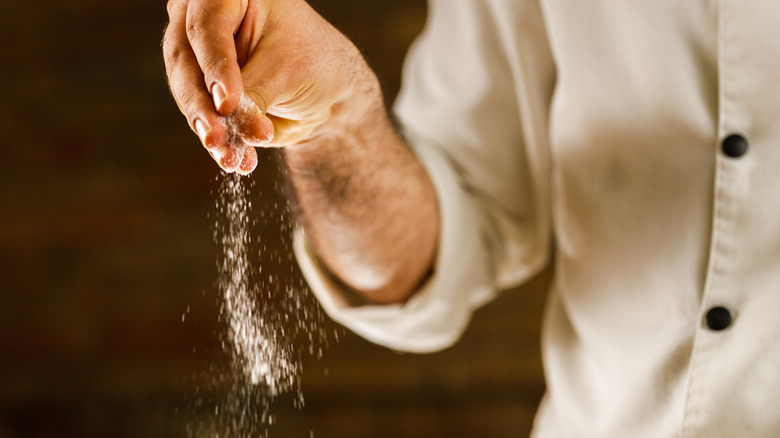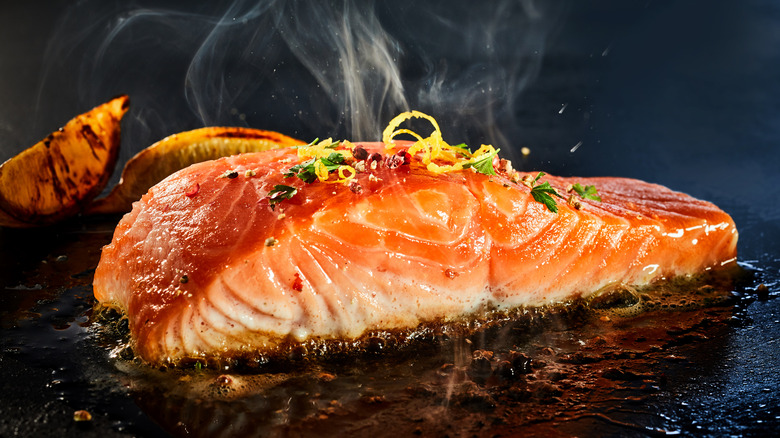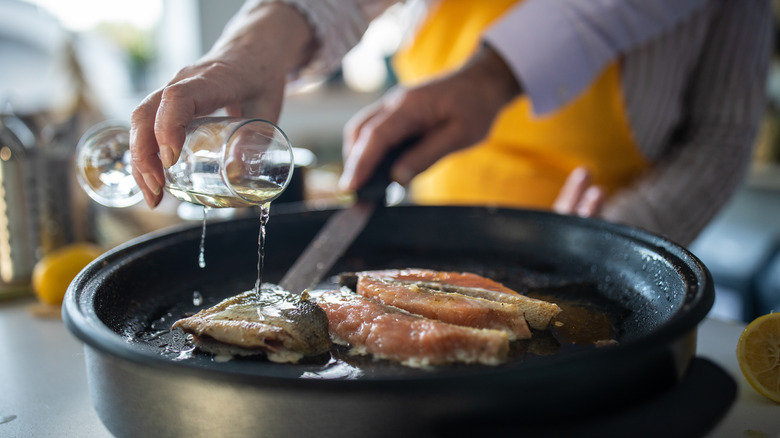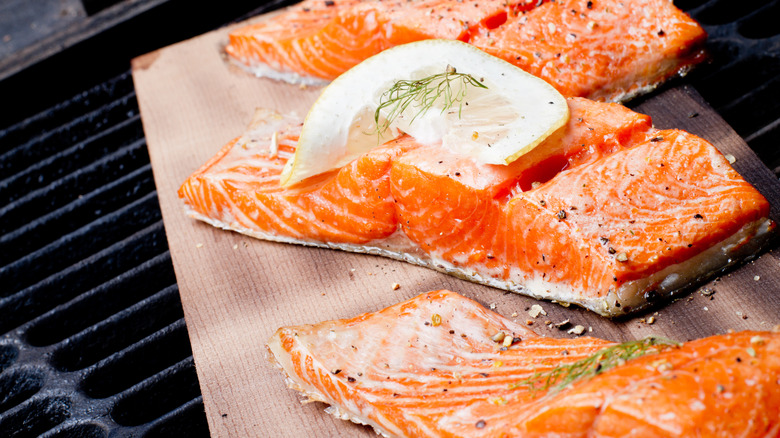Big Mistakes To Avoid When Cooking Fish
Learning to cook fish counts among one of the most delicious and sometimes challenging tasks the home cook can take on. Unlike other meats like beef or chicken, fish are an entirely different category altogether because so many different kinds of fish swim the seas, rivers, and lakes of the world. There are freshwater fish, like catfish, saltwater fish, like halibut, and shellfish, like shrimp and lobster. Although the same cooking methods may be used for more than one type of fish, this isn't always the case. Factors like fish thickness, skin or shell parameters, and more can add to the challenge. All of this amps up the intimidation factor for inexperienced cooks who want to broaden their fish-cooking skills.
Fortunately, armed with a list of fish-cooking tips and a few good seafood cookbooks, it's possible to become well-versed in the art of cooking fish. And while any list of tips having to do with cooking fish can't possibly cover everything you need to think about when it comes to cooking fish, it is possible to highlight some of the most common mistakes people make when they're cooking a meal from the waters of the world. Here's a look at just a few of the troubles you might encounter while mastering your fish-cooking skills.
Opting for a fish of a lesser quality
Of all the places in your food budget where you could cut corners, buying fish shouldn't count among them. Frankly, of all the kinds of foods that could cause you to spit up as a result of food poisoning, you probably don't want it to be fish that's had some time to sour in your stomach. Great-tasting cooked fish, even if it's an inexpensive type of fish like catfish or mackerel, always comes from the highest quality offerings you can find. And while it may seem counterintuitive, most fish that's fit to eat doesn't smell particularly fishy nor ammonia-ish. The eyes are clear, and the flesh and scales are firm. Healthy-looking pink or red gills are also something to look for. Fish filets should not have any indications of discoloration, dryness, or darkness around the outside, and shellfish with white interiors are what you should gravitate toward.
If you're not exactly experienced when it comes to buying quality fish, give yourself an added layer of protection. Shop for fish at grocery store chains and markets that have a reputation for stocking quality seafood or at a local specialty seafood market.
Buying fish that not everyone can eat
Turning non-seafood eaters into the seafood curious usually requires some coaxing on the part of fish eaters, as well as a Rolodex of the types of fish that don't offend the non-fish-eating palate. Fortunately, a number of milder-tasting fish swim the proverbial seven seas that are good candidates for this occasion. A good place to start is with a mild white fish, like the kind that fish sticks and fish patties are made from. This is usually Alaska pollock, but not always. Recipes for homemade fish sticks often also allow for tilapia, halibut, and cod fish. The point here isn't to talk about fish stick recipes per se but to point out that many of these recipes call for mild white fish because they don't taste fishy. For many fish haters, the fishy taste is one of the most off-putting aspects of eating the stuff.
Finally, be aware that some people may have dietary restrictions forbidding certain kinds of seafood. Kosher diets, for example, don't allow adherents to eat shellfish. They only eat fish with scales and fins, like salmon. If you're cooking for someone who eats a kosher diet, keep that in mind. Generally, it's always best to ask about dietary restrictions when cooking fish, or any food, really, for this reason.
Leaving the small bones inside the fish
Remember when you were a kid and got a fishbone stuck in your throat? To solve this revolting development, you probably slathered some peanut butter on some bread, took a bite, and swallowed the peanut buttery morsel with the intensity of the whale swallowing Jonah. That memory might bring on a bit of nostalgia for childhood, but the fact remains it would have been way more fun to have not swallowed the fishbone at all. This is the chief reason why it's important to be meticulous when removing the small bones from your fish. The possibility of choking is a big drawback for many people, especially those who aren't big fish fans, to begin with.
Called pin bones, they're as thin as needles and often difficult to see in the fish. This, in turn, makes them difficult to remove from the fish's flesh. However, there is a trick that makes removing them simple. Take a bowl that's large enough for you to drape the fish over and place the fish on it, skin side down. Doing this makes the bones pop up out of the flesh. From there, take a pair of tweezers and pull the bones out one at a time. Pay particular attention to the bones at the head. There are usually more there than anyplace else on the fish.
Cooking your fish too long
Cooking fish isn't like cooking a hefty slab of beef. Whereas beef has the physical constitution of Paul Bunyan, in a manner of speaking, fish flesh is often built more like a teenager in an anime film. This isn't always the case, of course, but this analogy points to the challenges that can arise if you cook fish for too long. Fish meat tends to be delicate, which means that it's easier to overcook without really trying to. It can cook in as little as four minutes.
Knowing the signs of doneness goes a long way in ensuring that your fish doesn't get overcooked. Fish that's done at the correct level of doneness flakes nicely. The juices that ooze out of it are white. The skin also turns crispy. There are no cooking hacks for fish as far as the correct temperature goes because different kinds of fish require different cooking temperatures. In light of that, just remember if the fish's texture turns hard, it's overdone.
Forgetting to dry it out a bit
Like other types of meat, fish meat benefits from being patted down with a paper towel before cooking. This act helps to absorb the moisture in the fish, which allows it to not only cook better but also retain the flavors of the seasonings that you've treated the meat with. Damp fish doesn't get the kind of seared exterior that you're hoping for. Instead, the moisture causes the fish to stick to the pan, which ultimately tears it apart as you try to remove it from the pan you're cooking it in. On a related note, excess moisture is also the reason why your breaded fish doesn't hold its breading. Too much moisture equals crumbled, damp breading.
It doesn't take much effort to remove the moisture from the fish. First, allow it to sit out at room temperature. Little pools of water will begin to form underneath the fish. Place the fish on a clean cutting board and lay a paper towel over it. Press into the fish gently to squeeze out the moisture.
Taking the skin off
For a long time, the thought of eating fish skins has caused weirdness among even those who like and eat fish, with some even believing that eating the skins of fish causes harm. In some instances, this can be the case, but mostly, whether or not it's safe to eat the skin of a fish comes down to the eater's palate preferences and the type of fish.
There are some general guidelines you follow if you're in doubt with respect to a piece of fish you're planning on cooking. First, if a fish comes from a reputable source, then it's okay to eat the skin, and in fact, doing so provides a number of nutritional benefits, including being a source of omega-3 fatty acids. Second, some types of fish have skin that tastes good, and others don't. In the stay-away-from-this category fall tuna, monkfish, swordfish, and shark. The skins of these fishes run tough and thick. Imagine eating a black leather jacket, and you have the right idea. If the fish you're eating has skin that your fork easily slices through, then you're golden.
This isn't to say that you need to cook all your fish skins off, even if you don't plan on eating the skin. Because fish meat is so delicate, it needs something to hold it together during the cooking process. Fish skin does that. It's also easier to handle and serve a fish that still has the skin on it.
Cooking shellfish and boned fish the same way
When it comes to cooking, fish and shellfish are not necessarily created equal. This means that the cooking methods and the length of time that you cook each type of fish can vary a lot. Fish also has a peculiarity that some other meats don't have. Unlike steak, for example, which is rare, medium-rare, and done, fish goes through the stages of not done, done, and something resembling the texture and consistency of a seaman's rubber boot. And while you can eat all stages of beef doneness, it's usually not the same with fish.
Generally speaking, the United States Department of Agriculture suggests that people cook their fish until the internal temperature is 145 F. This kills off any harmful bacteria that are hanging out in fishyland. After that, though, there is a range of temperatures that fish and shellfish should and could be inside. For example, lobster being thick, likes a temperature around 140 F. Tuna, on the other hand, is really better at 115 F. And here, tuna is a perfect example of how different fish have different doneness requirements. It's often raw on the inside and seared on the outside.
So, how do you know how long to cook fish for? One way is to follow what's called the 10-minute rule. Cook the fish for 10 minutes per inch, using the fish's thickest point as your reference. With this guide, some fish will cook for as few as five minutes. Other fish may cook for 20.
Cutting into the fish too soon
It isn't just the stove that cooks your fish. It's the space between, so to speak, that cooks it as well. More plainly, just because you've taken the fish off the burner doesn't mean that the cooking process stops. Meat, including fish meat, needs some resting time between the stove and the dinner table to allow it to finish cooking. Instead of cutting into the fish, give it a minute or two to breathe and allow the juices inside to redistribute themselves throughout the fish.
However, because the muscle fibers in fish meat are more delicate and structurally different than other kinds of meat, there are a couple of exceptions to this. In general, fish doesn't require the same amount of sitting time that beef does. And some fish, like tilapia, cod, and tuna, don't require a resting period at all. If a fish is thicker, more like a steak, then it can sit for up to 10 minutes. Salmon and monkfish are examples in this case.
Preparing the fish in a cool pan
Due to fish's delicate muscle makeup, it breaks apart easily during the cooking process. One cooking hack, in particular, prevents this eventuality and starts before the fish even hits the pan. If you heat up the pan before you toss the fish in, you'll minimize the likelihood of the fish meat crumbling and tearing apart in the pan. This encourages the meat to sear, creating a nice crisp texture on the skin of the fish. It seals in the flavor, making the fish moist and more flavorful.
To get started with this, put the pan on the stove on medium-high heat. Allow it to heat for a few minutes. Drop a few water droplets into the pan. When it sizzles and dances a jig in the pan, the pan is ready for your fish. Don't add oil first because it will splatter and sizzle. Work with water droplets to get the right temperature. Drizzle a little oil in after that and begin cooking your fish.
Not knowing how to make it more flavorful
Seasoning fish can be tricky because getting the seasoning just right depends on the type of fish you're working with. Some fish have such a subtle, delicate taste that the wrong seasoning or even too much of the right seasoning overpowers the flavor. In other cases, the flavor of fish is bold and memorable. The role of seasoning here comes down to enhancing the boldness of the flavor without trying to compete with it.
Therefore, having a list of go-to herbs and spices at your fingertips makes flavoring your fish a bit easier. On the most basic level, the perfect seasoning for fish can include salt, basil, dill, tarragon, ginger, and smoked paprika. Enhance the flavor of these seasonings further by keeping fresh lemon and soy sauce on hand.
If you'd like to simplify things a bit, native lemon pepper can replace the tanginess of lemon, plus add a bit of a spicy nip to your fish. And depending on the cooking method you've chosen, going even simpler in your choice of flavor enhancements allows you to taste the fish underneath the seasonings, so to speak. For that, a little salt and pepper, plus some olive oil and lemon or lime, work just fine.
Refusing to explore different cooking methods
Want to get a different flavor experience from eating fish without trying a new kind of fish and without necessarily adding a lot of new and exotic spices to your cupboard? It's easy if you know how to cook fish, even the same fish, more than one way. Consider salmon, for example. Poach it on Monday. Steam it on Tuesday. Grill it on Wednesday. Barbecue it on Thursday. And bake it on Friday. If you have any kind of culinary imagination at all, you'll understand how the same fish cooked five different ways could be so different. Better yet, if you consider yourself to be a person without a great culinary experience, you've now added five ways to cook the same fish to your cooking repertoire.
Further, even if the recipes have many of the same ingredients, like lemon, garlic, salt, and pepper, they all taste slightly different because the chemistry of cooking kicks in to alter the taste. Grilled fish, for example, tastes like the spices you put on it, plus the charcoal of the grill. You could cook fish 15 different ways in the same month without changing the kind of fish you're eating (if you feel so inclined). But it isn't just salmon that gets a flavor boost from different cooking methods. Most other kinds of fish do, too.
Handling the fish too much
From a physical perspective, fish are kind of the delicate flowers of the meat world. Due to their delicate muscle fibers, the slightest ding, nudge, or wonky turn of the spatula has the potential to tear the meat of the fish apart before it's even fried (or however you cook it). If any food should be mostly hands-off during the cooking process, fish is it.
But it's not just when you're handling the fish during the prep that's important. Once it's in the pan and has set to cooking, it's even more vulnerable to falling apart. The heat makes the muscle fibers start to flake. It's the quality that you love on the plate. That is, you love being able to stick the tines of your fork in the fish, twist, and watch all that moist, flaky fish break apart in the most delectable way. But ideally, it doesn't flake apart until it's sitting on your plate.
Keep in mind that fish tends to stick to the pan. Sticking means tearing. Let it cook mostly unhandled for a couple of minutes on one side before flipping it over to the other side. The less you manhandle it, the better. You can't avoid it entirely, but less is more here if you don't want it to fall apart.
Choosing to cook the skin side last
If you want tender fish, learning to cook the fish skin first is a good skill to know. Before moving any further on this topic, it's important to point out that not all fish should be cooked with the skin on, so this tip only applies to fish where that is the case. But for fish that should be cooked with the skin on, there are a couple of things to keep in mind. Ideally, the skin cooks until it's crisp, but it can't do that if there is excess moisture on the skin. Scrape the skin gently with the blade of a knife, wiping down the moisture that gathers on the knife and on the skin. Once the knife no longer comes up with extra moisture on the blade, it's ready to cook.
Start with a hot pan that has hot oil in it, and put the skin side of the fish down. If you've done this right, the fish shouldn't stick to the pan if you drag it along the bottom of the pan. Cook the fish on the skin side first for a couple of minutes. The length of time you cook it varies by fish type. Once it's mostly — but not fully — cooked, flip it over from its skin-side-down position and cook it on the flesh side for just a couple of minutes.

